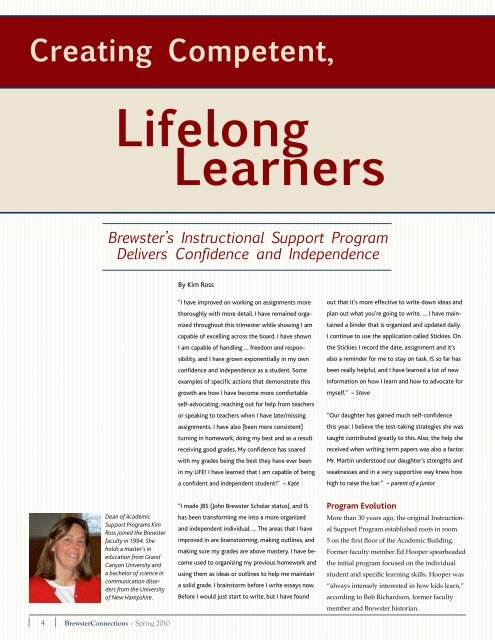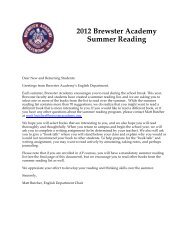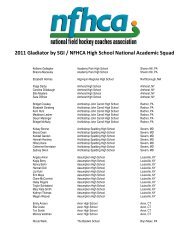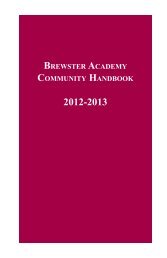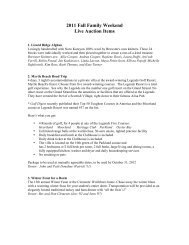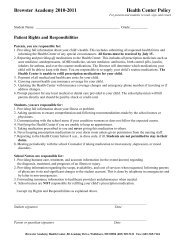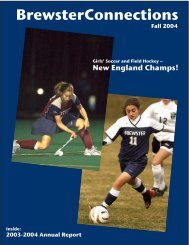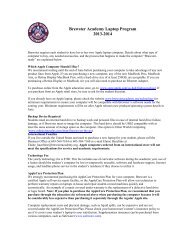BrewsterConnections - Brewster Academy
BrewsterConnections - Brewster Academy
BrewsterConnections - Brewster Academy
You also want an ePaper? Increase the reach of your titles
YUMPU automatically turns print PDFs into web optimized ePapers that Google loves.
Creating Competent,<br />
Lifelong<br />
Learners<br />
<strong>Brewster</strong>’s Instructional Support Program<br />
Delivers Confidence and Independence<br />
Dean of Academic<br />
Support Programs Kim<br />
Ross joined the <strong>Brewster</strong><br />
faculty in 1994. She<br />
holds a master’s in<br />
education from Grand<br />
Canyon University and<br />
a bachelor of science in<br />
communication disorders<br />
from the University<br />
of New Hampshire.<br />
By Kim Ross<br />
“I have improved on working on assignments more<br />
thoroughly with more detail. I have remained organized<br />
throughout this trimester while showing I am<br />
capable of excelling across the board. I have shown<br />
I am capable of handling … freedom and responsibility,<br />
and I have grown exponentially in my own<br />
confidence and independence as a student. Some<br />
examples of specific actions that demonstrate this<br />
growth are how I have become more comfortable<br />
self-advocating, reaching out for help from teachers<br />
or speaking to teachers when I have late/missing<br />
assignments. I have also [been more consistent]<br />
turning in homework, doing my best and as a result<br />
receiving good grades. My confidence has soared<br />
with my grades being the best they have ever been<br />
in my LIFE! I have learned that I am capable of being<br />
a confident and independent student!” ~ Kate<br />
“I made JBS (John <strong>Brewster</strong> Scholar status), and IS<br />
has been transforming me into a more organized<br />
and independent individual. … The areas that I have<br />
improved in are brainstorming, making outlines, and<br />
making sure my grades are above mastery. I have become<br />
used to organizing my previous homework and<br />
using them as ideas or outlines to help me maintain<br />
a solid grade. I brainstorm before I write essays now.<br />
Before I would just start to write, but I have found<br />
out that it’s more effective to write down ideas and<br />
plan out what you’re going to write. … I have maintained<br />
a binder that is organized and updated daily.<br />
I continue to use the application called Stickies. On<br />
the Stickies I record the date, assignment and it’s<br />
also a reminder for me to stay on task. IS so far has<br />
been really helpful, and I have learned a lot of new<br />
information on how I learn and how to advocate for<br />
myself.” ~ Steve<br />
“Our daughter has gained much self-confidence<br />
this year. I believe the test-taking strategies she was<br />
taught contributed greatly to this. Also, the help she<br />
received when writing term papers was also a factor.<br />
Mr. Martin understood our daughter’s strengths and<br />
weaknesses and in a very supportive way knew how<br />
high to raise the bar.” ~ parent of a junior<br />
Program Evolution<br />
More than 30 years ago, the original Instructional<br />
Support Program established roots in room<br />
5 on the first floor of the Academic Building.<br />
Former faculty member Ed Hooper spearheaded<br />
the initial program focused on the individual<br />
student and specific learning skills. Hooper was<br />
“always intensely interested in how kids learn,”<br />
according to Bob Richardson, former faculty<br />
member and <strong>Brewster</strong> historian.<br />
The program marked the beginning of a new<br />
chapter for <strong>Brewster</strong>, one that would challenge<br />
all faculty to recognize individual learning<br />
styles and appreciate that learning and life skills<br />
were as important to student success as mastering<br />
subject content. Moving toward a more<br />
student-centered approach, we began looking<br />
at how students learn and how to best design<br />
and deliver subject content that matched the<br />
student’s learning style. We also knew, however,<br />
that although we were engineering a program of<br />
instructional support, all students would be best<br />
served by a customized approach to maximizing<br />
their potential cognitively and emotionally.<br />
In 1993 Alan Bain, Ed.D., a learning specialist,<br />
was hired as director of the Instructional Support<br />
Program. Part of the program’s evolution<br />
was to change the emphasis from learning skills,<br />
which was more of a finite focus, to instructional<br />
support, which connotes ongoing action.<br />
<strong>Brewster</strong> recognized that tutoring students in<br />
specific core subjects was a Band-Aid approach,<br />
a very short-term way of gaining success. We<br />
were interested in teaching learning and life<br />
skills that would lead to long-term success be-<br />
yond <strong>Brewster</strong>. Realizing the critical importance<br />
of having well-trained faculty versed in a common<br />
philosophy and identified best practices,<br />
Bain launched a two-week intensive training<br />
program for IS faculty. The training program<br />
was the predecessor to today’s <strong>Brewster</strong> Summer<br />
Institute (BSI).<br />
Best Practices for All Learners<br />
A five-year plan was laid out providing organizational<br />
systems and learning structures<br />
designed to support a student-centered, collaborative<br />
approach to meeting the unique and<br />
diverse needs of all learners. Changes began<br />
with identifying best practices that were wellestablished<br />
approaches for all learners, building<br />
a leveled curriculum, ensuring what was tested<br />
was taught and mastered, and integrating technology<br />
as a tool for accessing and communicating<br />
knowledge. Academic teams were created<br />
within grades to maintain a low student-teacher<br />
ratio. As soon as plans were in place for how to<br />
best educate the student, the physical space underwent<br />
change to support the educational model.<br />
The Wilson Center for Teaching and Learning<br />
was designed to optimize the team approach<br />
– clustering core and IS classrooms, faculty<br />
team rooms, and labs within each of the seven<br />
academic team areas. Instead of one classroom<br />
for all students enrolled in instructional support,<br />
students could attend IS classes in their academic<br />
team area. Teachers now had a common<br />
area where they could effectively collaborate in<br />
support of students. With classrooms just steps<br />
away, IS teachers could observe the student<br />
implementing a newly learned skill in a core<br />
subject. A student might practice notetaking<br />
using Inspiration software during his history<br />
class while his IS teacher observes. Shortly after,<br />
the IS teacher and student would use their class<br />
time to discuss the effectiveness of the tool and<br />
its application.<br />
By 1995 I became dean of Academic Support<br />
Programs overseeing both the Instructional Support<br />
and English as a Second Language (ESL)<br />
programs. Each team included two IS teachers<br />
whose role as learning specialists was to educate,<br />
guide, and advocate for the student’s learning<br />
strengths and needs, along with playing a<br />
collaborative role in designing and modifying<br />
curriculum to place the student in the best position<br />
to master both skills and content.<br />
4 <strong><strong>Brewster</strong>Connections</strong> – Spring 2010 www.brewsteracademy.org 5


